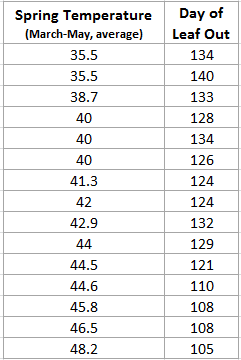The Timing of Red Maple Leaf-out
In the spring, red maples grow new leaves to replace the leaves that were shed in preparation for winter. This yearly event is called leaf-out. Triggers in the environment, such as the temperature, amount of precipitation and the length of daylight can affect the timing of leaf-out. In this activity, you will use the data provided to explore the timing of leaf-out in northern New England.
Part A
Do red maple trees leaf-out at the same time each year?
Signs of the Seasons observers have been recording the day that leaves are first visible on red maple trees for the past four spring seasons. Create a graph that compares recorded leaf-out days by year. A box plot for each year is one possible way to compare them.
2011: 123, 124, 124, 128, 129, 130, 132, 133, 137, 142
2012: 92, 105, 108, 108, 108, 110, 111, 113, 113, 115, 115, 115, 121, 121, 121, 123, 123, 130, 135
2013: 118, 120, 121, 122, 122, 122, 123, 129, 129, 130, 134
2014: 124, 128, 128, 133, 134, 134, 134, 134, 140, 140
Data from the Nature’s Notebook Database; first recorded day of visible leaves per site at a phenophase intensity of <50%
Analysis
1. What does the graph suggest about the yearly timing of red maple leaf out?
2. What are some similarities between the years? What are some differences?
Part B
During the spring, the sun travels higher through the sky, providing more hours of daylight and additional warmth. Many species are sensitive to these seasonal changes and some will adjust their life cycle events (phenophases) based on the surrounding environmental conditions. In this activity, you will use a data set to examine temperature as a possible trigger for leaf-out in red maples.
Is there a correlation between the day of leaf out and spring temperatures?

Using data from the NOAA archives, an average spring temperature was calculated for each site that reported leaf-out. Create a scatter plot to determine if there is a relationship between the average spring temperature and the timing of leaf-out at a site.
Analysis
1. Does this graph support or refute the hypothesis that leaf-out is related to spring temperatures?
2. Based on the graph, how would you describe the relationship between spring temperatures and leaf-out?
Authors: Elissa Koskela (University of Maine Cooperative Extension), Dr. Molly Schauffler (University of Maine Climate Change Institute and RiSE Center)
